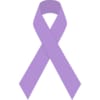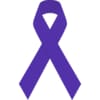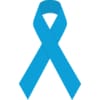
While most people know that pink represents breast cancer, most people don't know the awareness ribbon colors for other causes. Find them on this post along with more details and related charities. While most of our products don't feature cancer awareness ribbons so that they can be worn on more of an everyday basis, we do offer products in a wide variety of colors so that you can still show support for your favorite cause. You may also want to read about the history of the awareness ribbon.
All cancers

Color: Lavender
See all purple t-shirts & purple ribbon hats & products
Appendix cancer

Color: Amber
Appendix cancer is one of the rarest cancers, with less than 1,000 people being diagnosed with it in the United States each year. Because of this, there is not a lot of research done on it. Many times the symptoms are similar to appendicitis. Since these symptoms don’t appear until the cancer has progressed, it is usually diagnosed at a much later stage than other cancers.
See our yellow (amber) products
Related sites:
Bladder cancer



Colors: Blue, marigold, and purple
Awareness month: May
Bladder cancer is the fifth most common type of cancer, and when treated early it has a very high rate of success. While it is most common in men, women can also get bladder cancer. Approximately 2.4 percent of men and women will develop this type of cancer in their lifetime. Bladder cancer awareness month is in May, so be sure to look out for events during this month to help show your support.
See products available in Blue, Marigold/Yellow and Purple plus Purple Ribbon Hats and Yellow Ribbon hats
Related sites:
Brain tumor

Color: Grey
Awareness month: May
Primary brain tumors - those that begin in the brain and tend to stay in the brain - occur in people of all ages, but they are statistically more frequent in children and older adults. Metastatic brain tumors - those that begin as a cancer elsewhere in the body and spread to the brain - are more common in adults than children.
See our grey t-shirts, hats & hoodies and our hats with grey ribbons
Related sites:
Breast cancer

Color: Pink
Awareness month: October
About 1 in 8 U.S. women (about 12%) will develop invasive breast cancer over the course of her lifetime. A woman’s risk of breast cancer nearly doubles if she has a first-degree relative (mother, sister, daughter) who has been diagnosed with breast cancer. Less than 15% of women who get breast cancer have a family member diagnosed with it. The most significant risk factors for breast cancer are gender (being a woman) and age (growing older).
See our breast cancer awareness & pink ribbon hats or pink products including tees & caps
Related sites:
- National Breast Cancer Foundation
- Breast Cancer Research Foundation
- American Breast Cancer Foundation
Carcinoid cancer

Color: Zebra print
Awareness month: November
Each year, about 8,000 adults in the United States are diagnosed with a carcinoid tumor in their GI tract. The most common place in the GI tract for this type of tumor is the small intestine. People are most often diagnosed in their early 60s. The 5-year survival rate tells you what percent of people live at least 5 years after the cancer is found. Percent means how many out of 100. However, the survival rate depends on many factors, including the location of the tumor.
See our products in black and white and our black ribbon hats
Related sites:
Cervical cancer


Colors: Teal and white
Awareness month: January
Cervical cancer was once one of the most common causes of cancer death for American women. But over the last 40 years, the cervical cancer death rate has gone down by more than 50%. The main reason for this change was the increased use of the Pap test. This screening procedure can find changes in the cervix before cancer develops. It can also find cervical cancer early − in its most curable stage. Cervical cancer tends to occur in midlife. Most cases are found in women younger than 50. It rarely develops in women younger than 20.
See our products in teal and white
Related sites:
Childhood cancer

Color: Gold
Awareness month: September
Each year, the parents of approximately 15,700 kids will hear the words “your child has cancer.” Across all ages, ethnic groups and socio-economics, this disease remains the number one cause of death by disease in children. Despite major advances – from an overall survival rate of 10 percent just fifty years ago to nearly 90 percent today, for many rare cancers, the survival rate is much lower. Furthermore, the number of diagnosed cases annually has not declined in nearly 20 years.
See our yellow/gold products and our hats featuring yellow ribbons
Related sites:
- St. Jude Children’s Research Hospital
- American Childhood Cancer Organization
- National Pediatric Cancer Foundation
Colon cancer

Color: Dark Blue
Awareness month: March
Colon cancer is the third most commonly diagnosed cancer and the second leading cause of cancer death in men and women combined in the United States. The American Cancer Society estimates that this year 95,520 people will be diagnosed with colon cancer, 39,910 will be diagnosed with rectal cancer, and 50,260 will die from this disease. On average, the lifetime risk of developing colon cancer is about one in 23 for men and women combined (4.5%), however, this varies widely according to individual risk factors.
See our blue t-shirts, hoodies & caps and our colon cancer awareness hats
Related sites:
Endometrial cancer

Color: Peach
Awareness month: September
Endometrial cancer affects mainly postmenopausal women. The average age of women diagnosed with endometrial cancer is 60. It is uncommon in women under the age of 45.
This cancer is slightly more common in white women, but black women are more likely to die from it. There are more than 600,000 survivors of endometrial cancer.
See our pink & orange products
Related sites:
Esophageal cancer

Color: Periwinkle
Awareness month: April
Esophageal cancer makes up about 1% of all cancers diagnosed in the United States, but it is much more common in some other parts of the world, such as Iran, northern China, India, and southern Africa. Although many people with esophageal cancer will go on to die from this disease, treatment has improved and survival rates are getting better. During the 1960s and 1970s, only about 5% of patients survived at least 5 years after being diagnosed. Now, about 20% of patients survive at least 5 years after diagnosis. This number includes patients with all stages of esophageal cancer. Survival rates for people with early stage cancer are higher.
See our products in blue/periwinkle
Related sites:
Gallbladder cancer

Color: Green
Awareness month: February
This year, an estimated 11,740 adults (5,320 men and 6,420 women) in the United States will be diagnosed with gallbladder and other biliary cancers. In that estimate, about 4,000 are specifically gallbladder cancers. Incidence rates of gallbladder cancer are 66% higher in women than in men. It is estimated that 3,830 deaths (1,630 men and 2,200 women) from these diseases will occur this year. The 5-year survival rate tells you what percent of people live at least 5 years after the cancer is found. Percent means how many out of 100. The 5-year survival rate for people with gallbladder cancer is 19%. However, the survival rate depends on several factors, including the extent of cancer at the time of diagnosis
See our green t-shirts & caps and our green ribbon hats
Related sites:
Head and neck cancer


Colors: Burgundy and ivory
Awareness week: April 2–9, 2017
The incidence of head and neck cancer increases with age, especially after 50 years of age. Although most patients are between 50 and 70 years old, younger patients can develop head and neck cancer. There are more women and fewer smokers in the younger patient group with oral cavity cancers and no known risk factors.
See our products in burgundy and white/ivory and our hats with burgundy ribbons
Related sites:
Hodgkin’s lymphoma

Color: Violet
Awareness month: September
This year, an estimated 8,260 people (4,650 men and 3,610 women) in the United States will be diagnosed with Hodgkin lymphoma. It is estimated that 1,070 deaths (630 men and 440 women) from this disease will occur this year. The survival rate has been going up the past 40 years thanks to treatment improvements
See our shirts & other products in purple/violet and purple ribbon hats
Related sites:
Kidney cancer

Color: Orange
Awareness month: March
The average age of people when they are diagnosed is 64. Kidney cancer is very uncommon in people younger than age 45. Kidney cancer is among the 10 most common cancers in both men and women. Overall, the lifetime risk for developing kidney cancer is about 1 in 63 (1.6%)
See our orange t-shirts & our hats featuring orange ribbons
Related sites:
Leiomyosarcoma

Color: Purple
Awareness day: July 15
Leiomyosarcoma (LMS) is a type of soft tissue sarcoma. Soft tissue sarcomas can develop in muscle, fat, blood vessels, or any of the other tissues that support, surround and protect the organs of the body. Leiomyosarcoma is one of the more common types of soft tissue sarcoma to develop in adults.
See our products in purple and our hats with purple ribbons
Related sites:
Leukemia

Color: Orange
Awareness month: September
Leukemia begins in a cell in the bone marrow. The cell undergoes a change and becomes a type of leukemia cell. Once the marrow cell undergoes a leukemic change, the leukemia cells may grow and survive better than normal cells. Over time, the leukemia cells crowd out or suppress the development of normal cells. The rate at which leukemia progresses and how the cells replace the normal blood and marrow cells are different with each type of leukemia.
See our lymphoma awareness hats & orange t-shirts
Related sites:
Liver cancer

Color: Emerald
Awareness month: October
Your liver is the largest organ inside your body. It helps your body digest food, store energy, and remove poisons. Primary liver cancer starts in the liver. Metastatic liver cancer starts somewhere else and spreads to your liver. Symptoms can include a lump or pain on the right side of your abdomen and yellowing of the skin. However, you may not have symptoms until the cancer is advanced. This makes it harder to treat. Doctors use tests that examine the liver and the blood to diagnose liver cancer. Treatment options include surgery, radiation, chemotherapy, or liver transplantation.
See our products in emerald green and our hats with green ribbons
Related sites:
Lung cancer

Color: White
Awareness month: November
Lung cancer is by far the leading cause of cancer death among both men and women; about 1 out of 4 cancer deaths are from lung cancer. Each year, more people die of lung cancer than of colon, breast, and prostate cancers combined. Lung cancer mainly occurs in older people.
See our white tshirts, hats & accessories and our hats with white ribbons
Related sites:
Melanoma and skin cancer

Color: Black
Awareness month: May
An estimated 87,110 new cases of invasive melanoma will be diagnosed in the U.S. in 2017. An estimated 9,730 people will die of melanoma in 2017. Melanoma accounts for less than one percent of skin cancer cases, but the vast majority of skin cancer deaths. The vast majority of melanomas are caused by the sun.
See our black t-shirts, hoodies & hats and our melanoma & skin cancer hats with black ribbons
Related site:
Multiple myeloma

Color: Burgundy
Awareness month: March
It is estimated that 12,590 deaths (6,660 men and 5,930 women) from this disease will occur this year. The 5-year survival rate tells you what percent of people live at least 5 years after the cancer is found. Percent means how many out of 100. The 5-year survival rate for people with multiple myeloma is about 49%.
See our products in burgundy and our Multiple Myeloma awareness hats
Related site:
Non-Hodgkin’s lymphoma

Color: Lime green
Awareness month: September
Non-Hodgkin lymphoma (NHL) is one of the most common cancers in the United States, accounting for about 4% of all cancers. The American Cancer Society's most recent estimates for non-Hodgkin's lymphoma are for 2017: About 72,240 people (40,080 males and 32,160 females) will be diagnosed with NHL. Survival rates for NHL vary widely, depending on the lymphoma type, stage, age of the patient, and other variables. According to the American Cancer Society, the overall 5-year relative survival rate for patients with non-Hodgkin's lymphoma is 63% and the 10-year relative survival rate is 51%.
See our lymphoma awareness hats and green t-shirts & hats
Related sites:
Ovarian cancer

Color: Teal
Awareness month: September (and May 8)
Ovarian cancer ranks fifth in cancer deaths among women, accounting for more deaths than any other cancer of the female reproductive system. A woman's risk of getting ovarian cancer during her lifetime is about 1 in 75. Her lifetime chance of dying from ovarian cancer is about 1 in 100.
See our products available in teal
Related sites:
Pancreatic cancer

Color: Purple
Awareness month: November
Lifetime risk of pancreatic cancer. The average lifetime risk of pancreatic cancer for both men and women is about 1 in 65 (1.5%). But each person's chances of getting this cancer can be affected by certain risk factors
See our purple t-shirts & baseball caps and our hats with purple ribbons
Related sites:
Prostate cancer

Color: Light blue
Awareness month: September
Prostate cancer is the third leading cause of cancer death in American men, behind lung cancer and colorectal cancer. About 1 man in 39 will die of prostate cancer.
Prostate cancer can be a serious disease, but most men diagnosed with prostate cancer do not die from it. In fact, more than 2.9 million men in the United States who have been diagnosed with prostate cancer at some point are still alive today.
Find prostate cancer awareness hats with light blue ribbons
Related sites:
Sarcoma (bone cancer)

Color: Yellow
Awareness month: July
It’s a rare type of cancer recognized in July through Sarcoma Awareness Month and it's yellow-colored ribbon. And, if you didn’t know anything about sarcoma, now is a good time to learn. There’s a reason you typically don’t hear much about sarcoma. It’s a relatively rare type of cancer, causing a relatively small amount of diagnoses. That’s why it’s so important to be aware – because otherwise, you might not realize what’s going on until it’s too late.
See our yellow products and yellow ribbon hats for Sarcoma awareness
Related site:
Stomach cancer

Color: Periwinkle
Awareness month: November
About 6 of every 10 people diagnosed with stomach cancer each year are 65 or older. The average risk that a person will develop stomach cancer in their lifetime is about 1 in 111. This risk is higher in men than in women, and can also be affected by a number of other factors.
See our products available in blue/periwinkle
Related sites:
Testicular cancer

Color: Orchid
Awareness month: April
The incidence rate of testicular cancer has been increasing in the United States and many other countries for several decades. The increase is mostly in seminomas. Experts have not been able to find reasons for this increase. Lately, the rate of increase has slowed. Testicular cancer is not common; about 1 of every 263 males will develop testicular cancer at some point during their lifetime. The average age at the time of diagnosis of testicular cancer is about 33. This is largely a disease of young and middle-aged men, but about 7% of cases occur in children and teens, and about 7% occur in men over the age of 55.
See our t-shirts and hats available in purple/violet and our products with purple ribbons
Related sites:
Thyroid cancer



Colors: Teal, pink, and blue
Awareness month: September
The number of deaths was 0.5 per 100,000 men and women per year. These rates are age-adjusted and based on 2010-2014 cases and deaths. Lifetime Risk of Developing Cancer: Approximately 1.2 percent of men and women will be diagnosed with thyroid cancer at some point during their lifetime, based on 2012-2014 data.
See our products available in teal, pink & blue
Related sites:
Colors Associated with other Causes
Alzheimer’s

Color: Purple
Awareness month: June
The number of Americans living with Alzheimer's disease is growing — and growing fast. ... Of the estimated 5.5 million Americans living with Alzheimer's dementia in 2017, an estimated 5.3 million are age 65 and older and approximately 200,000 individuals are under age 65 and have younger-onset Alzheimer's.
See our t-shirts & hats in purple and our Alzheimer's awareness hats
Related sites:
HIV/AIDS

Color: Red
Awareness Day: December 1st
HIV is short for human immunodeficiency virus. It works by harming your immune system and destroying white blood cells. These cells are important because it is what your boy uses to fight infection. Having a low white blood cell count can also put you at risk for a serious infection and some cancers. HIV can progress into AIDS, acquired immunodeficiency syndrome. Aids is the final stage of infection with HIV.
See our red t-shirts, hats & sweatshirts and our red ribbon hats for HIV/AIDS awareness
Related sites:
AIds United
Parkinson's

Color: Grey
Awareness month: April
As many as one million Americans live with Parkinson’s disease, which is more awareness than the combined number of people diagnosed with multiple sclerosis, muscular dystrophy and Lou Gehrig’s disease. Approximately 60,000 Americans are diagnosed with Parkinson’s disease each year, and this number does not reflect the thousands of cases that go undetected.
An estimated seven to 10 million people worldwide are living with Parkinson’s disease.
See our grey t-shirts, hats, sweatshirts & accessories and our Parkinson's awareness hats with grey ribbons
Related sites:
Multiple Sclerosis

Color: Orange
Awareness month: March
Prevalence. The Multiple Sclerosis Foundation estimates that more than 400,000 people in the United States and about 2.5 million people around the world have MS. About 200 new cases are diagnosed each week in the United States. Rates of MS are higher farther from the equator.
See our orange t-shirts & our MS awareness hats
Related sites:
- National Multiple Sclerosis Society
- Multiple Sclerosis Foundation
- The Multiple Sclerosis Association of America
Spinal cord injuries

Color: Green
Awareness month: September
The term 'spinal cord injury' refers to damage to the spinal cord resulting from trauma (e.g. a car crash) or from disease or degeneration (e.g. cancer). There is no reliable estimate of global prevalence, but estimated annual global incidence is 40 to 80 cases per million population.
See our green t-shirts and hats and our hats with green ribbons
Related sites:
- Spinal Cord Injury Resource Center
- National Spinal Cord Injury Association
- Christopher & Dana Reeve Foundation
Autism

Color: In addition to the puzzle piece, the official color for National Autism Awareness Month is a bright royal blue.
Awareness month: April
In 2016, the Centers for Disease Control’s Autism and Developmental Disabilities Monitoring (ADDM) reported that approximately 1 in 68 children in the United States has been identified with an Autism Spectrum Disorder (ASD). This rate remains the same as in 2014, which is the first time it has not risen. However, with respect to older data, this new estimate is roughly 30 percent higher than the previous estimate of 1 in 88 children reported in 2012. In the 1980s autism prevalence was reported as 1 in 10,000. In the nineties, prevalence was 1 in 2500 and later 1 in 1000.
See our products available in all shades of blue
Related sites:
Epilepsy

Color: Purple
Awareness month: November
Epilepsy by the Numbers: Facts, Statistics, and You. Epilepsy is a neurological disorder caused by unusual nerve cell activity in the brain. Each year, about 150,000 Americans are diagnosed with the central nervous system disorder that causes seizures. Over a lifetime, one in 26 people will be diagnosed with it.
See our products available in purple and our hats with purple ribbons
Related sites:



